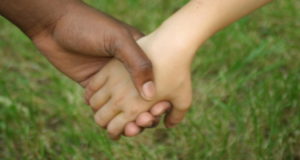|
Listen To The Article
|
…and then there were other people on the island. We called them the Others, and they started attacking us. —Hurley, Lost (2009)
The primary role of anthropology thus was a process of ‘inventing the human other’ in order to develop a theory of humankind. —Sundar Sarukkai, “The ‘Other’ in Anthropology and Philosophy” (1997)
The Children’s Story
The war is over, and they have won. This is the background for James Clavell’s short classic, The Children’s Story (1981). Clavell shows us a class of second graders in some generic school after the fall of the United States to an unnamed Marxist power. These second graders know that “they” have conquered “us,” and they are afraid. Their teacher, too, is afraid—afraid for her students, her children. Together teacher and children watch the classroom door, expecting at any moment one of Them to appear. But when the door finally opens, the children gasp.
They had expected an ogre or giant or beast or witch or monster—like the outer-space monster you think about when the lights are out and Momma and Daddy have kissed you good night and you’re frightened and you put your head under the cover….
What they see, in fact, is a beautiful young girl. Her clothes are neat and clean… her perfume is fresh… and her movements are graceful. She speaks perfect English without the hint of an accent. And she interacts with the children in a way that is both reassuring and intriguing. Within twenty minutes she has won their confidence and undermined the outward forms and traditions that represent their parents’ religious and political convictions. They story is powerful, and its implications for education are profound. But our concern here is with the idea of Them. For as the children understood well, we normally think of Them as monsters.
The Other as Them
 Anthropology is supposed to be the science of humanity. But traditional anthropology is inherently biased. Growing up as it did in the West in the wake of the Enlightenment, it organized its assumptions and categories in terms of Cartesian rationality and Western technological progress. Modern Western man became the standard of true, fully evolved humanity. Other men or man-like beings were sorted out on a downward scale from that starting point. “Thus, there is a plethora of human others which appear in anthropology,” Sundar Sarukkai writes. Following Jacob Pandian, he lists the fossil other, the savage other, the black other, and the ethnographic other. In other words, traditional anthropology defines the truly human as that which is not pre-historic man, the savage, the black, or the man described in the ethnographic accounts of obscure non-Western cultures. What is implicit here, of course, is racism, the inherent superiority of the Western white man, and the right of the West to dominate less “human” peoples. Along these lines, Sarukkai writes:
Anthropology is supposed to be the science of humanity. But traditional anthropology is inherently biased. Growing up as it did in the West in the wake of the Enlightenment, it organized its assumptions and categories in terms of Cartesian rationality and Western technological progress. Modern Western man became the standard of true, fully evolved humanity. Other men or man-like beings were sorted out on a downward scale from that starting point. “Thus, there is a plethora of human others which appear in anthropology,” Sundar Sarukkai writes. Following Jacob Pandian, he lists the fossil other, the savage other, the black other, and the ethnographic other. In other words, traditional anthropology defines the truly human as that which is not pre-historic man, the savage, the black, or the man described in the ethnographic accounts of obscure non-Western cultures. What is implicit here, of course, is racism, the inherent superiority of the Western white man, and the right of the West to dominate less “human” peoples. Along these lines, Sarukkai writes:
Thus, the idea of the non-western people as the living fossil drew support from the historical and biological theories of the times. Consistently, the other stood for an inferior human….
The non-western people were seen to embody what the primeval west was before its “progress” and thus were seen as “living fossils.” The historical growth of these ideas show inherent ideas of domination.
Now that anthropology is no longer a Western monopoly, non-Western anthropologists are challenging the very foundations of the discipline. But even they are left with the nagging questions. How do we define the truly human? How should we judge between one culture and another? Should we? In avoiding the very idea of the Other, or Them, are we left with anything but cultural relativism? Does anthropology have anything left to offer but endless volumes of meaningless description?
The Little Girl and “Them”
In stark contrast to traditional anthropology—and to the second graders in A Children’s Story—stands the little Israelite maid who appears 2 Kings 5. This little girl—we don’t know her name or age—had been carried captive by the armies of Syria. The Syrians had pillaged her town and most likely murdered her family and friends. They certainly had taken her away from everything she knew: her nation, her language, her forms of worship, and her way of life.
This little girl ended up a servant in the household of Naaman, a Syrian general, one of “them.” Naaman was a leper. The little girl might easily have concluded that he was under the direct judgment of God; in her mind, many lepers were. She might have thought, “Serves him right!” But the little girl thought no such thing. Rather, she said to her mistress, “Would God my lord were with the prophet that is in Samaria! For he would recover him of his leprosy.”
What an amazing girl! A stranger in a strange land, she maintained her faith in God and her love for those around her. She harbored no bitterness or hatred toward her captors. She wished Naaman well. She wanted him to be healed. And she was certain that Elisha the prophet could heal him, even though no prophet had ever healed a leper before. She was certain that Elisha would heal him, even though Naaman was a Gentile and one of “them.” She believed this even though “many lepers were in Israel in the time of Elisha the prophet, and none of them was cleansed” (Luke 4:27). This little girl believed that God is merciful to all who call upon Him (Rom. 10:12-13). For her, Naaman was not one of “them”; he was not an “other.” He was made in the image of God, a sinner like herself who needed the mercy of God.
Imago Dei
Scripture teaches that man is made in the image of God (Gen. 1:26-28). He is a created and finite replica of the infinite and transcendent Creator. Man’s definition and reference point thus lie outside himself in Another. But that Other is “nigh” unto all those who call upon Him in truth (Ps. 145:18). Scripture teaches both the infinite ontological distance between the Creator and His creation and the real possibility of covenant fellowship between God and man. Yahweh is the “high and lofty One who inhabits eternity,” yet He dwells with the humble and contrite (Isa. 57:15). He is the self-revealing God, the Source of all light and truth.
For Scripture, then, man is most truly man when he knows and fears God (Ecc. 12:13). The best in humanity is that which conforms to the law of God. Want of conformity to that law is sin, corruption, and depravity. Such lawlessness alienates man from God, and man from man. And so the sinner finds enemies on every side.
Selective Depravity
Because of sin, it is natural for each man to think of himself and those like him as sane, moral, normal—in fact, human. Those outside his group—the “others,” the “outsiders,” “they”—are, from his perspective, deranged, depraved, and deviant. They are even inhuman. This perception or categorization strikes at the heart of Christian ethics. Here’s why: Those who embrace this heresy can safely say amen to God’s demand for love and yet find no one worthy of that love because only me and my little group are truly human. It was just this sort of attitude in a Pharisaical lawyer that prompted Christ to tell the parable of the Good Samaritan (Luke 10:25-37).
In an extreme form such an attitude generates what Rushdoony has called the heresy of “selective depravity.” We, the insiders, locate or absolutize evil in some ethnic, cultural, or religious group that we’re not in.
Depravity is limited to a class or group. Instead of seeing the problem as sin, and sin as pandemic to all men in Adam, selective depravity sees sin as limited to a segment of humanity. Instead of fighting against sin, it calls upon us to fight against a particular group of men. This means a radically different plan of salvation than that which is set forth in Scripture. Instead of Jesus Christ as the Savior of all men… it sees one segment of humanity, the “good guys,” as the world’s hope. The problem then is to exorcise the “bad guys.” (937)
At its worst, the doctrine of selective depravity leads to Pharisaism, murder, and genocide.
Conclusion
It’s easy for the natural man to fear and hate “the other,” simply because “the other” is well, other than himself. It’s natural for the sinner to see “the others” as murdering monsters who need to be exterminated from the universe. Modern anthropologists may suspect smell an ovious rat here and sense a need for some sort of ethical band-aid as they really have no moral reference point to appeal. They have they have only the dust and ashes of cultural relativism, in terms of which all attitudes and actions must ultimately be acceptable.
Scripture, on the other hand, gives us an absolute standard in the law of God and true spiritual power for obedience in the gospel of Jesus Christ. Man can be saved from his self-centeredness, hatred, and fear. He can become a covenant keeper in Jesus Christ. Through the power of the Spirit, he can truly learn to love his neighbor, even his enemy, as he loves himself.
For Further Reading:
James Clavell, The Children’s Story (New York: Delacorte Press/Eleanor Friede, 1981).
Greg Uttinger, “If You Only Had a Few Years…,” The Chalcedon Report
Rousas J. Rushdoony, “Doctrine of Selective Depravity” in The Roots of Reconstruction, 936-942 (Vallecito, CA: Ross House Books, 1991).
Sundar Sarukkai, “The ‘Other’ in Anthropology and Philosophy,” Economic and Political Weekly, Vol. 32, No. 24 (Jun. 14-20, 1997), 1406-1409.
 Off The Grid News Better Ideas For Off The Grid Living
Off The Grid News Better Ideas For Off The Grid Living




